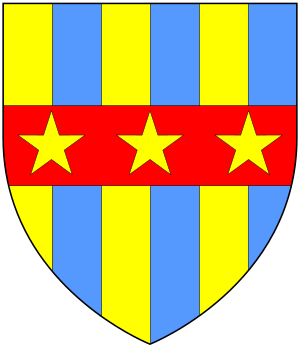John Clanvowe facts for kids
Sir John Clanvowe (born around 1341 – died October 17, 1391) was an important person from Wales. He was a diplomat, a poet, and a special knight who worked closely with Richard II, the King of England. John Clanvowe came from a family in the Welsh Marches, which is the border area between England and Wales. He owned land in what is now Powys (in Wales) and Herefordshire (in England).
A Knight's Journey
John Clanvowe was born in Hergest, Herefordshire. His family had connections to the royal court, and his own career serving the king began in 1373 under Edward III. He quickly became friends with powerful people at court, including William Neville.
When Richard II became king (1377–1399), Clanvowe gained more trust. By 1381, he became a "chamber knight." This meant he was a trusted advisor and close helper to the king. His main job was to help keep peace in his home county of Herefordshire and make the king popular there. He left this role in 1388 but stayed active in politics. He even helped with peace talks with France in 1389, which led to a three-year break in fighting.
Outside of his royal duties, Clanvowe was a good friend of the famous poet Geoffrey Chaucer. People believe Clanvowe was one of the first to hear Chaucer's story, The Knight's Tale, even before it became part of The Canterbury Tales. In 1386, Clanvowe and Chaucer even gave evidence in a court case about who had the right to use a certain family symbol (a coat of arms).
Clanvowe died on October 17, 1391, while traveling to Constantinople with his close friend, William Neville. They might have been going on a religious journey. Neville died just two days later, perhaps heartbroken after losing his friend. They were buried together in a shared tomb found in 1913 in Istanbul, Turkey. Their tombstone shows their family symbols joined together on their shields, a sign of how very close they were, often used for married couples.
Military Adventures
Early in his life, Clanvowe was likely trained by Humphrey de Bohun, 7th Earl of Hereford. He may have joined a military trip to Alexandria in 1365. He also took part in battles in France during The Hundred Years War, starting in 1364.
Later, in 1373 and 1378, Clanvowe joined military trips to France led by John of Gaunt. In 1390, he went on another military trip, this time to Tunis in North Africa. This trip ended with a peace treaty after a nine-week siege.
His Beliefs
Sir John Clanvowe was known for having some different ideas about religion. A writer from that time, Thomas Walsingham, even listed him as one of the seven "lollard knights." These knights followed certain new religious ideas that were not always approved by the Church.
Historians have discussed how different Clanvowe's beliefs truly were. When studying his religious book, "The Two Ways," some historians suggest he had different views because he didn't mention many parts of the English Church that would normally be important. His focus on the Bible suggested he felt people could connect with God directly, without needing many church ceremonies. However, other historians argue that his work didn't contain ideas from John Wycliffe, a famous religious reformer. They believe his views were more like strict religious ideas, rather than ideas that went against the Church.
His Writings
Clanvowe probably wrote his book The Two Ways during his trip to Constantinople in 1391. This book describes how people can follow a "narrow way" to heaven and avoid a "broad way" that leads to trouble. In it, he criticized his own knightly class, saying that they (and other Christians) should live a humble life and not focus too much on worldly pleasures.
Clanvowe's most famous work is The Book of Cupid, God of Love, also known as The Cuckoo and the Nightingale. This is a poem where a nightingale praises love, but a cuckoo makes fun of it, saying love causes more problems than joy. The poem is written like a dream and is an example of medieval debate poetry, where different ideas are discussed.
Modern scholars first mentioned Clanvowe in 1896. For a long time, The Cuckoo and the Nightingale was thought to be written by Chaucer. However, there isn't clear proof linking Chaucer to the poem, and it is now generally believed to be Clanvowe's work.


